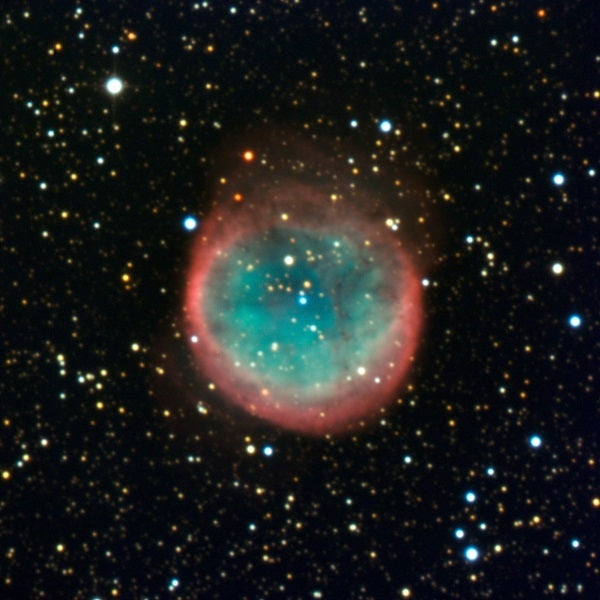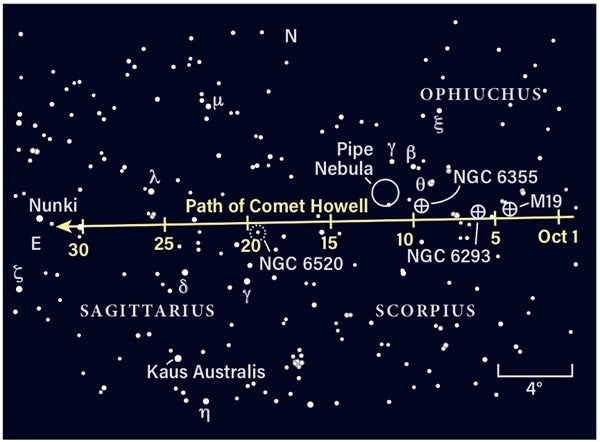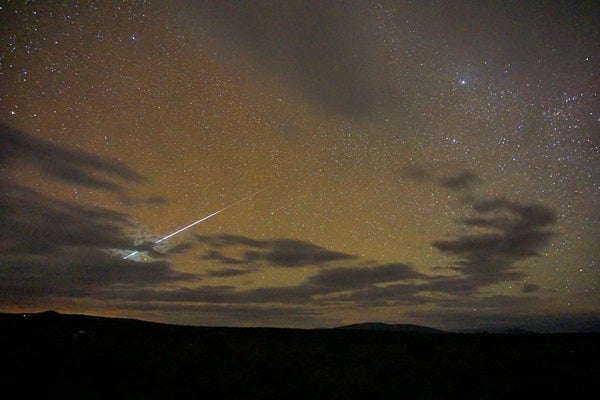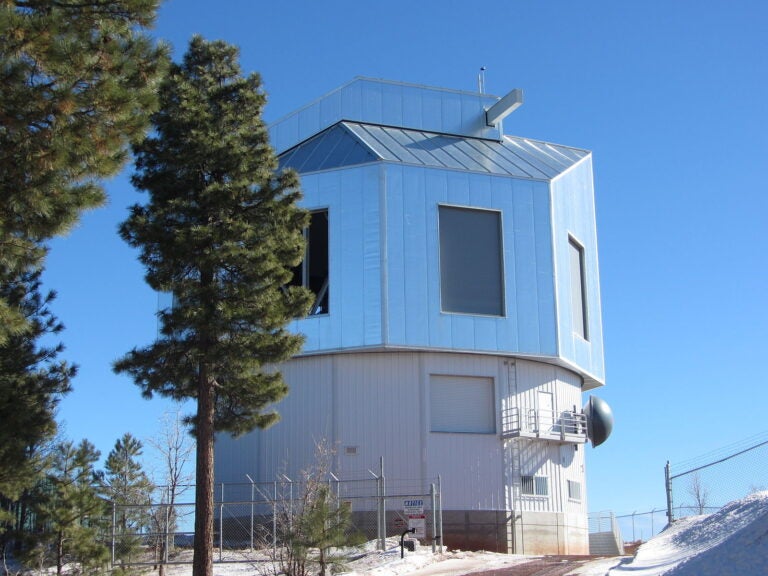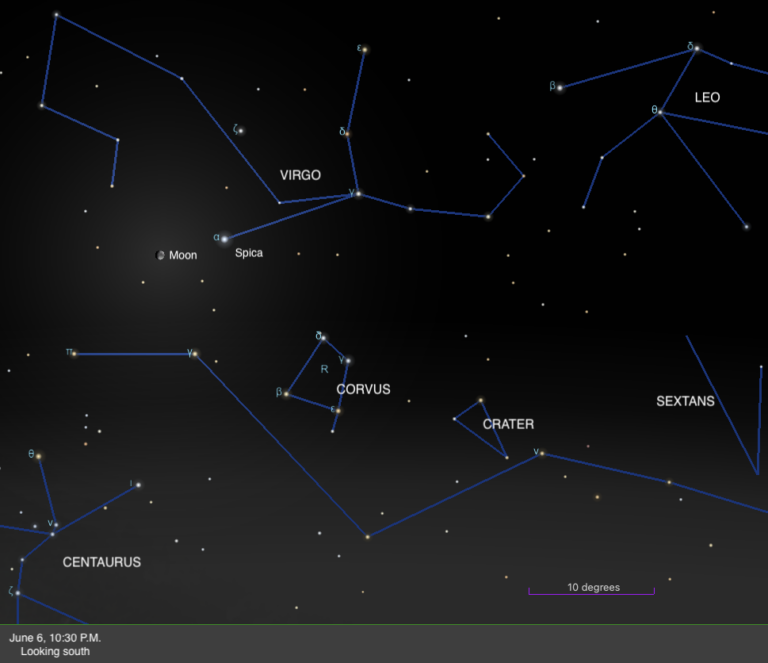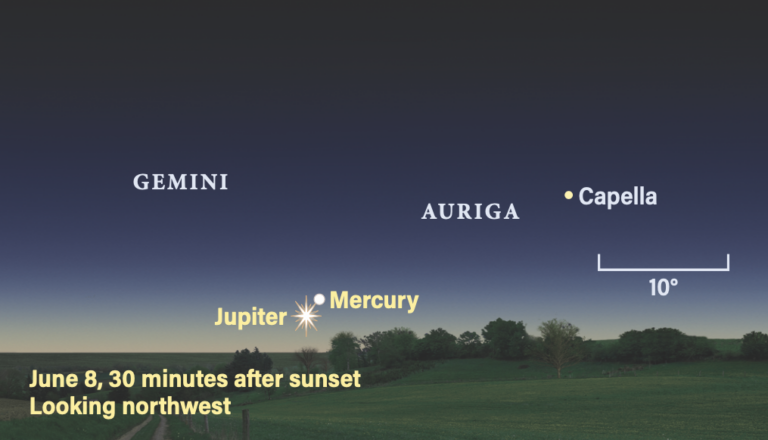Tonight is the perfect night to give the Great Globular Cluster in Hercules a peek. Cataloged as M13, this massive cluster contains more than 100,000 stars and shines at magnitude 5.8, making it the second brightest in the northern sky. Even with a nearly Full Moon up tonight, binoculars or a telescope should bring out many of M13’s myriad stars, which cover a region nearly 17′ across.
To find it, locate Hercules high in the western sky after sunset. He’ll be oriented slightly sideways, with the stars Zeta (ζ) and Eta (η) Herculis, which make up one side of his torso, closer to the horizon. Look two-thirds of the way from Zeta to Eta, and you’ll run smack-dab into M13.
If you want to compare M13 with the Northern Hemisphere’s brightest globular, you’re in luck — M5 is also above the western horizon after sunset. M5 is lower than M13; it’s nearly level with the bright star Arcturus and lies about 23° southeast of the star. This cluster glows at magnitude 5.7 and is 17.4′ across, making it another great binocular or telescopic object. The larger your aperture, the more stars you’ll see — this is true for both M13 and M5.
Sunrise*: 6:58 A.M.
Sunset: 6:40 P.M.
Moonrise: 7:27 P.M.
Moonset: 7:30 A.M.
Moon Phase: Waning gibbous (99%)
*Times for sunrise, sunset, moonrise, and moonset are given in local time from 40° N 90° W. The Moon’s illumination is given at 12 P.M. local time from the same location.
Saturday, October 3
The Moon reaches apogee — the farthest point from our planet in its orbit — at 1:22 P.M. EDT. At that time, it will be 252,476 miles (406,321 kilometers) from Earth.
Finally starting to noticeably wane from Full, our satellite rises near Uranus tonight. An hour after moonrise, the two are 5.7° apart and closing in. They’ll reach just 4.3° apart by 2 A.M. EDT on the 4th. You will find the pair between the bright stars Hamal in Aries and Menkar in Cetus. Uranus appears as a magnitude 5.7 starlike object and its 4″-wide disk is best caught with binoculars or a telescope tonight, given the Moon’s glare.
West-southwest of the duo is bright Mars in Pisces; we’ll come back to the Red Planet later this week. Keep looking west, past Pisces, to find Neptune in eastern Aquarius. The farthest planet from the Sun is currently magnitude 7.8, but should be visible with optical aid, despite the Moon’s bright background light.
Sunrise: 6:59 A.M.
Sunset: 6:38 P.M.
Moonrise: 7:51 P.M.
Moonset: 8:27 A.M.
Moon Phase: Waning gibbous (97%)
Sunday, October 4
Pluto is stationary against the background stars at 2 A.M. EDT this morning. It will now reverse its westerly motion, making a tight turn to begin moving east. You can find the dwarf planet this evening after sunset, sinking toward the horizon between Jupiter and Saturn in the south. The trio is northeast of Sagittarius’ Teapot asterism, to the upper left of the handle in the sky.
Jupiter and Saturn are 7° apart tonight, with Pluto nestled between them. The tiny dwarf is 3° southwest of Saturn and 4° east of Jupiter. You’ll need a decent-sized telescope to find its magnitude 14.3 glow, but the gas giants flanking it are visible to the naked eye. Once you’ve found Pluto, also take some time to admire the bigger, brighter targets of Jupiter and Saturn. They’ll continue setting earlier each evening, disappearing by 11 P.M. local time before the end of the month.
Sunrise: 7:00 A.M.
Sunset: 6:36 P.M.
Moonrise: 8:16 P.M.
Moonset: 9:26 A.M.
Moon Phase: Waning gibbous (93%)
Comet 88P/Howell is traveling through a star-studded region of the southwestern sky early this month. There’s a dark-sky window for about an hour tonight before moonrise, and you’ll want to use it to snag a glimpse of Howell sandwiched between globular clusters M19 to its west and NGC 6293 to its east. There’s plenty more to see nearby as well: globular cluster NGC 6355 and the Pipe Nebula sit a little farther to the comet’s east, and 12.8° east of Howell is open cluster NGC 6520.
A 4-inch telescope under dark skies will net you the view; those in more light-polluted areas will want a bigger aperture. The best signpost to find the comet is Antares in Scorpius — Howell floats about 8.2° due east of the bright red luminary tonight.
Today is also the 97th anniversary of Edwin Hubble’s identification of Cepheid variable stars in M31, perhaps better known as the Andromeda Galaxy. These stars allowed for an accurate distance measurement to M31, proving that, at 2.5 million light-years, this object isn’t inside the Milky Way, but actually another galaxy altogether.
If you get outside early enough after dark, you’ll have the best chance of spotting M31 in the east. Clear, dark skies may offer a glimpse of this galactic fuzz with no optical aid at all, as it’s typically the farthest object you can see with the naked eye. Binoculars or a telescope will certainly bring it out, although heavy light pollution will make your search more difficult.
Once the Moon rises, instead consider searching for the prototype classical Cepheid, Delta (δ) Cephei. This magnitude 6.3 star lies just southeast of the “house” asterism made up of Cepheus’ brightest stars, which sits high in the northeast after moonrise. Delta is about 2.4° due east of brighter magnitude 3.4 Zeta Cephei; search with binoculars or a low-powered telescope to find Delta, and know you’re looking at an important tool that astronomers now use to measure vast distances beyond the Milky Way.
Sunrise: 7:01 A.M.
Sunset: 6:35 P.M.
Moonrise: 8:45 P.M.
Moonset: 10:25 A.M.
Moon Phase: Waning gibbous (87%)
Mars comes closest to Earth at 10 A.M. EDT this morning. At that time, the Red Planet will sit just 0.41 astronomical unit (1 astronomical unit is the average Earth-Sun distance), or 38.6 million miles (61.3 million km) from our planet. The best time to view it will be later this evening, when it’s high above the horizon in the hours before local midnight.
Mars is currently glowing at magnitude –2.6 in the east; tonight, it’s just 23′ from Mu (μ) Piscium, but the planet far outshines the magnitude 4.8 star. Under higher magnification, you may be able to see dark Syrtis Major and the bright Hellas basin on the planet’s 23″-wide disk. Both are relatively front and center around 11 P.M. EDT, but are visible for several hours before and after this time.
To the east, a bright waning gibbous Moon brightens the sky in Taurus. Our satellite is a little less than 5° from the Bull’s brightest star, Aldebaran, which should still be visible despite the glare. Just below them, Orion the Hunter is beginning to rise; his body should just clear the horizon by midnight for observers in the northern half of the U.S.
Sunrise: 7:02 A.M.
Sunset: 6:33 P.M.
Moonrise: 9:19 P.M.
Moonset: 11:25 A.M.
Moon Phase: Waning gibbous (81%)
The Draconid meteor shower is ramping up this evening to a peak tomorrow morning. Despite the fact that most meteor showers are best viewed in the early morning hours, this one is better in the late evening. Although this periodic shower has produced some impressive shows, it’s scheduled for relative mediocrity this year with a maximum rate around 10 meteors per hour. But the Draconids can surprise observers with much higher rates; if it’s clear, consider stepping outside late tonight and casting your gaze high in the northwest. The shower’s radiant in Draco the Dragon is about 19° northwest of Vega; you’ll want to look somewhat away from the radiant for the best chance to catch these slow-moving meteors.
Sunrise: 7:03 A.M.
Sunset: 6:32 P.M.
Moonrise: 9:58 P.M.
Moonset: 12:24 P.M.
Moon Phase: Waning gibbous (72%)
Thursday, October 8
Tonight is one of your last chances to catch Mercury in the evening sky. By 30 minutes after sunset, the tiny planet is just 2° high in the southwest. It sets 15 minutes later, well on its way to inferior conjunction with the Sun on October 25. After that, the solar system’s smallest, speediest planet will become an early morning object in November.
Mercury is now magnitude 0.1 — still bright and easy to spot, particularly with binoculars or a telescope. Its disk, which is a little less than 50 percent lit, spans 8″.
As the planet sinks out of sight in the deepening twilight, you’ll see several bright stars pop into view: Antares, the red heart of Scorpius, and orange-hued Arcturus, the brightest star in Boötes. Look farther south and you’ll also see Jupiter (magnitude –2.4) and Saturn (magnitude 0.5) amid the stars of Sagittarius. Directly overhead, the Summer Triangle still rules, comprised of the bright stars Deneb, Altair, and Vega.
Sunrise: 7:04 A.M.
Sunset: 6:30 P.M.
Moonrise: 10:45 P.M.
Moonset: 1:23 P.M.
Moon Phase: Waning gibbous (63%)
Friday, October 9
Last Quarter Moon occurs at 8:40 P.M. EDT tonight. Because our satellite rises so late, this evening is the perfect time to seek out dimmer, deep-sky objects that would be obscured by its light. If you’re a seasoned observer with a good scope, consider searching out several of Aquila’s planetary nebulae: NGC 6804, NGC 6781, NGC 6741, NGC 6772, and NGC 6751. They range from magnitude 11 to 13, so the size of your aperture and your skill at spotting dim objects will both come into play. Astroimagers may have more luck getting these stunningly beautiful dying stars to show up in longer exposures, and an Oxygen-III filter can further help bring out their soft glow.
If you’re looking for slightly brighter targets, turn your scope to NGC 6755 and NGC 6756, two open clusters located about 4.5° west-northwest of Delta Aquilae. Nearby are also two globular clusters — NGC 6749 and NGC 6760 — 3.2° and 4.8° east of Theta (θ) Serpentis, respectively.
Sunrise: 7:05 A.M.
Sunset: 6:28 P.M.
Moonrise: 11:40 P.M.
Moonset: 2:17 P.M.
Moon Phase: Waning gibbous (53%)

